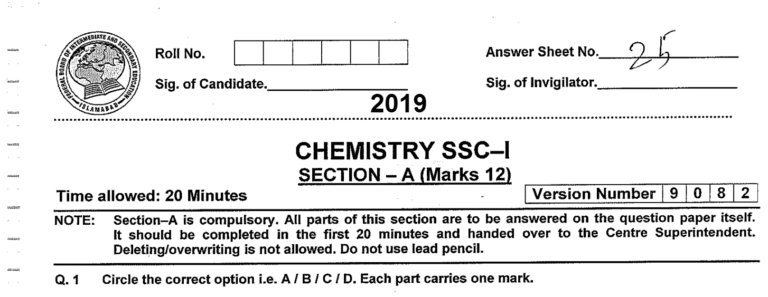Pakistan Studies 9 Solved Paper 2017 Federal Board
Class 9 Pakistan Studies Solved Paper 2017
Class 9 Pakistan Studies Solved Paper 2017 for Federal Board is available in this post. You can see more FBISE solved past papers of class 9 on our website.
Class 9 Pakistan Studies Solved Paper 2017
Section A
Q1. MCQs
Class 9 Pakistan Studies Solved Paper 2017
Section B
Q2.
(i) What do you mean by faith in Prophethood?
Ans. Faith in Prophethood means to believe that Allah sent messengers for the guidance of mankind. All prophets were human beings, they were not endowed with divinity the revelation descended upon them all of them were innocent and they did never commit a sin.
(ii) Write down the names of members of Cabinet Mission.
Ans. The members of the Cabinet Mission Plan 1946 were:-
1. Sir Stafford Cripps
2. Mr. A.V. Alexander
3. Lord Pethic Lawrence
(iii) How did Quaid-e-Azam (RA) get the title of ‘Ambassador of Peace’?
Ans. Under Lucknow pact, Quaid-e-Azam united both of the nations (the Hindus and the Muslims) in 1916. He got the right of separate electorate for the Muslims acknowledged and got the title of ‘Ambassador of Peace’.
(iv) Name three leaders of N.W.F.P (Khyber Pakhtun Khawa) Muslim League who took active part for success of referendum in 1947.
Ans. Leaders of the Muslim League, Sardar Abdur Rab Nishtar, Khan Abdul Qayyum Khan, and Peer Manki toured the whole of the province and took an active part in the referendum in 1947.
(v) Give a brief account of martyrdom of Tipu Sultan.
Ans. Ryder Ali, the ruler of Myrose, a powerful Muslim state, resisted against the increasing force of the British manfully. After the death of Hyder Ali, his son Sultan Fateh Ali Khan Tipu continued Jihad against the British. The British formed an alliance with the Nizam of Hyderabad and Marhattas in 1799. And martyred Sultan Tipu in the Battle of Myrose. With the death of Sultan Tipu, not only Myrose was occupied by the British, but their authority began to expand other areas. Sultan Tipu was given proper burial ceremony by the company officials. He was an enlightened ruler treated his Hindu subjects with an open mind. He introduced new warfare technologies and new ways of agricultural production.
(vi) State any three causes of Soil Pollution.
Ans. Major causes of soil pollution are as under:-
a) Releasing used water of houses and factories.
b) Spraying pesticides on crops and using chemical fertilizers.
c) Natural disasters such as earth quakes and floods etc.
d) Salinity and water logging.
e) Heaps of domestic and industrial wastage.
(vii) Into how many natural regions Pakistan is divided? Also give names.
Ans. Pakistan is divided into the following five natural regions:
1. Plain Region
2. Desert Region
3. Coastal Region
4. Tropical and Sub-tropical Region
5. Dry and semi-dry Mountain Region
(viii) Enumerate any six threats to wildlife in Pakistan.
Ans. Following are the threats to wildlife in Pakistan:
(a) Illegal Hunting
(b) Poor Planning
(c) Continues increase in human population
(d) Deforestation
(e) Shortage of water
(f) Shortage of fodder due to increase in the number of domestic animals
(g) Disappearance of wild sanctuaries
(ix) Define Economic Development.
Ans. The growth of an economy from backward to advanced economy is known as Economic Development. It is a process through which such changes are introduced in economy by adopting and utilizing modern, advanced, capital and human resources as increase the income of the country. The living standard of the people rises. The masses enjoy better opportunities of education, health, employment and recreation.
(x) When and who administered the oath of Governor General from Quaid-e-Azam (RA)?
Ans. On 15 August 1947, when Quaid-i-Azam Muhammad Ali Jinnah was sworn in as the first Governor-General of Pakistan, Chief Justice Sir Rashid administered the oath of office to him.
(xi) Which important airfields of India were destroyed by Pakistan Air Force during 1965 war?
Ans. During 1965 war, Pakistan Air Force attacked on Indian airfields at Pathankot, Adampur and Halwara. The attack on Pathankot was a great success, as the Indian Air Force lost almost ten aircraft on the ground at Pathankot, while the attacks on Adampur and Halwara were failures.




